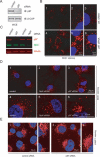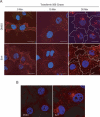The p97 ATPase associates with EEA1 to regulate the size of early endosomes
- PMID: 21556036
- PMCID: PMC3271578
- DOI: 10.1038/cr.2011.80
The p97 ATPase associates with EEA1 to regulate the size of early endosomes
Abstract
The AAA (ATPase-associated with various cellular activities) ATPase p97 acts on diverse substrate proteins to partake in various cellular processes such as membrane fusion and endoplasmic reticulum-associated degradation (ERAD). In membrane fusion, p97 is thought to function in analogy to the related ATPase NSF (N-ethylmaleimide-sensitive fusion protein), which promotes membrane fusion by disassembling a SNARE complex. In ERAD, p97 dislocates misfolded proteins from the ER membrane to facilitate their turnover by the proteasome. Here, we identify a novel function of p97 in endocytic trafficking by establishing the early endosomal autoantigen 1 (EEA1) as a new p97 substrate. We demonstrate that a fraction of p97 is localized to the early endosome membrane, where it binds EEA1 via the N-terminal C2H2 zinc finger domain. Inhibition of p97 either by siRNA or a pharmacological inhibitor results in clustering and enlargement of early endosomes, which is associated with an altered trafficking pattern for an endocytic cargo. Mechanistically, we show that p97 inhibition causes increased EEA1 self-association at the endosome membrane. We propose that p97 may regulate the size of early endosomes by governing the oligomeric state of EEA1.
Figures







Similar articles
-
Unconventional p97/VCP-Mediated Endoplasmic Reticulum-to-Endosome Trafficking of a Retroviral Protein.J Virol. 2021 Jun 24;95(14):e0053121. doi: 10.1128/JVI.00531-21. Epub 2021 Jun 24. J Virol. 2021. PMID: 33952644 Free PMC article.
-
Involvement of the endosomal autoantigen EEA1 in homotypic fusion of early endosomes.Curr Biol. 1998 Jul 16;8(15):881-4. doi: 10.1016/s0960-9822(07)00351-x. Curr Biol. 1998. PMID: 9705936
-
Function of the p97-Ufd1-Npl4 complex in retrotranslocation from the ER to the cytosol: dual recognition of nonubiquitinated polypeptide segments and polyubiquitin chains.J Cell Biol. 2003 Jul 7;162(1):71-84. doi: 10.1083/jcb.200302169. J Cell Biol. 2003. PMID: 12847084 Free PMC article.
-
p97/p47-Mediated biogenesis of Golgi and ER.J Biochem. 2005 Feb;137(2):115-9. doi: 10.1093/jb/mvi028. J Biochem. 2005. PMID: 15749824 Review.
-
Expanding into new markets--VCP/p97 in endocytosis and autophagy.J Struct Biol. 2012 Aug;179(2):78-82. doi: 10.1016/j.jsb.2012.03.003. Epub 2012 Mar 19. J Struct Biol. 2012. PMID: 22450227 Review.
Cited by
-
Role of FQQI motif in the internalization, trafficking, and signaling of guanylyl-cyclase/natriuretic peptide receptor-A in cultured murine mesangial cells.Am J Physiol Renal Physiol. 2016 Jan 1;310(1):F68-84. doi: 10.1152/ajprenal.00205.2015. Epub 2015 Sep 16. Am J Physiol Renal Physiol. 2016. PMID: 26377794 Free PMC article.
-
Endocytic Adaptor Protein HIP1R Controls Intracellular Trafficking of Epidermal Growth Factor Receptor in Neuronal Dendritic Development.Front Mol Neurosci. 2018 Dec 6;11:447. doi: 10.3389/fnmol.2018.00447. eCollection 2018. Front Mol Neurosci. 2018. PMID: 30574069 Free PMC article.
-
Proliferating cell nuclear antigen (PCNA)-binding protein C1orf124 is a regulator of translesion synthesis.J Biol Chem. 2012 Oct 5;287(41):34225-33. doi: 10.1074/jbc.M112.400135. Epub 2012 Aug 17. J Biol Chem. 2012. PMID: 22902628 Free PMC article.
-
Transcriptional profiling and dynamical regulation analysis identify potential kernel target genes of SCYL1-BP1 in HEK293T cells.Mol Cells. 2014 Sep;37(9):691-8. doi: 10.14348/molcells.2014.0184. Epub 2014 Sep 18. Mol Cells. 2014. PMID: 25234469 Free PMC article.
-
The role of autophagy in the pathogenesis and treatment of amyotrophic lateral sclerosis (ALS) and frontotemporal dementia (FTD).Autophagy Rep. 2025 Mar 20;4(1):2474796. doi: 10.1080/27694127.2025.2474796. eCollection 2025. Autophagy Rep. 2025. PMID: 40395983 Free PMC article. Review.
References
-
- DeLaBarre B, Brunger AT. Complete structure of p97/valosin-containing protein reveals communication between nucleotide domains. Nat Struct Biol. 2003;10:856–863. - PubMed
-
- Zhang X, Shaw A, Bates PA, et al. Structure of the AAA ATPase p97. Mol Cell. 2000;6:1473–1484. - PubMed
-
- Jentsch S, Rumpf S. Cdc48 (p97): a “molecular gearbox” in the ubiquitin pathway. Trends Biochem Sci. 2007;32:6–11. - PubMed
-
- Ye Y. Diverse functions with a common regulator: ubiquitin takes command of an AAA ATPase. J Struct Biol. 2006;156:29–40. - PubMed
Publication types
MeSH terms
Substances
Grants and funding
LinkOut - more resources
Full Text Sources
Research Materials

